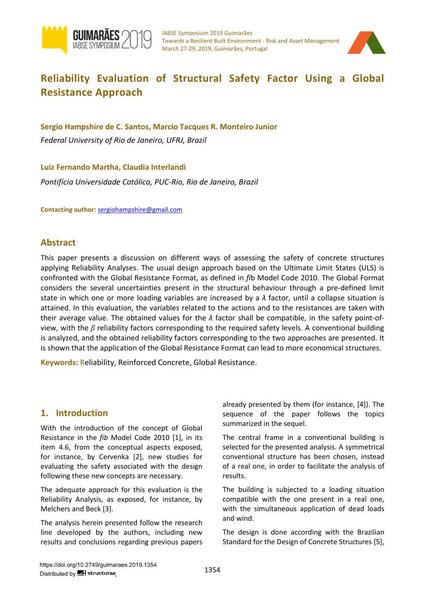Reliability Evaluation of Structural Safety Factor Using a Global Resistance Approach

|
|
|||||||||||
Bibliographic Details
| Author(s): |
Sergio Santos
(Federal University of Rio de Janeiro, UFRJ, Brazil)
Marcio Tacques R. Monteiro Junior (Federal University of Rio de Janeiro, UFRJ, Brazil) Luiz Fernando Martha (Pontifícia Universidade Católica, PUC-Rio, Rio de Janeiro, Brazil) Claudia Interlandi (Pontifícia Universidade Católica, PUC-Rio, Rio de Janeiro, Brazil) |
||||
|---|---|---|---|---|---|
| Medium: | conference paper | ||||
| Language(s): | English | ||||
| Conference: | IABSE Symposium: Towards a Resilient Built Environment Risk and Asset Management, Guimarães, Portugal, 27-29 March 2019 | ||||
| Published in: | IABSE Symposium Guimarães 2019 | ||||
|
|||||
| Page(s): | 1354-1361 | ||||
| Total no. of pages: | 8 | ||||
| DOI: | 10.2749/guimaraes.2019.1354 | ||||
| Abstract: |
This paper presents a discussion on different ways of assessing the safety of concrete structures applying Reliability Analyses. The usual design approach based on the Ultimate Limit States (ULS) is confronted with the Global Resistance Format, as defined infib Model Code 2010. The Global Format considers the several uncertainties present in the structural behaviour through a pre-defined limit state in which one or more loading variables are increased by aλfactor, until a collapse situation is attained. In this evaluation, the variables related to the actions and to the resistances are taken with their average value. The obtained values for theλfactor shall be compatible, in the safety point-of- view, with the β reliability factors corresponding to the required safety levels. A conventional building is analyzed, and the obtained reliability factors corresponding to the two approaches are presented. It is shown that the application of the Global Resistance Format can lead to more economical structures. |
||||
| Keywords: |
reliability reinforced concrete Global Resistance
|
||||
